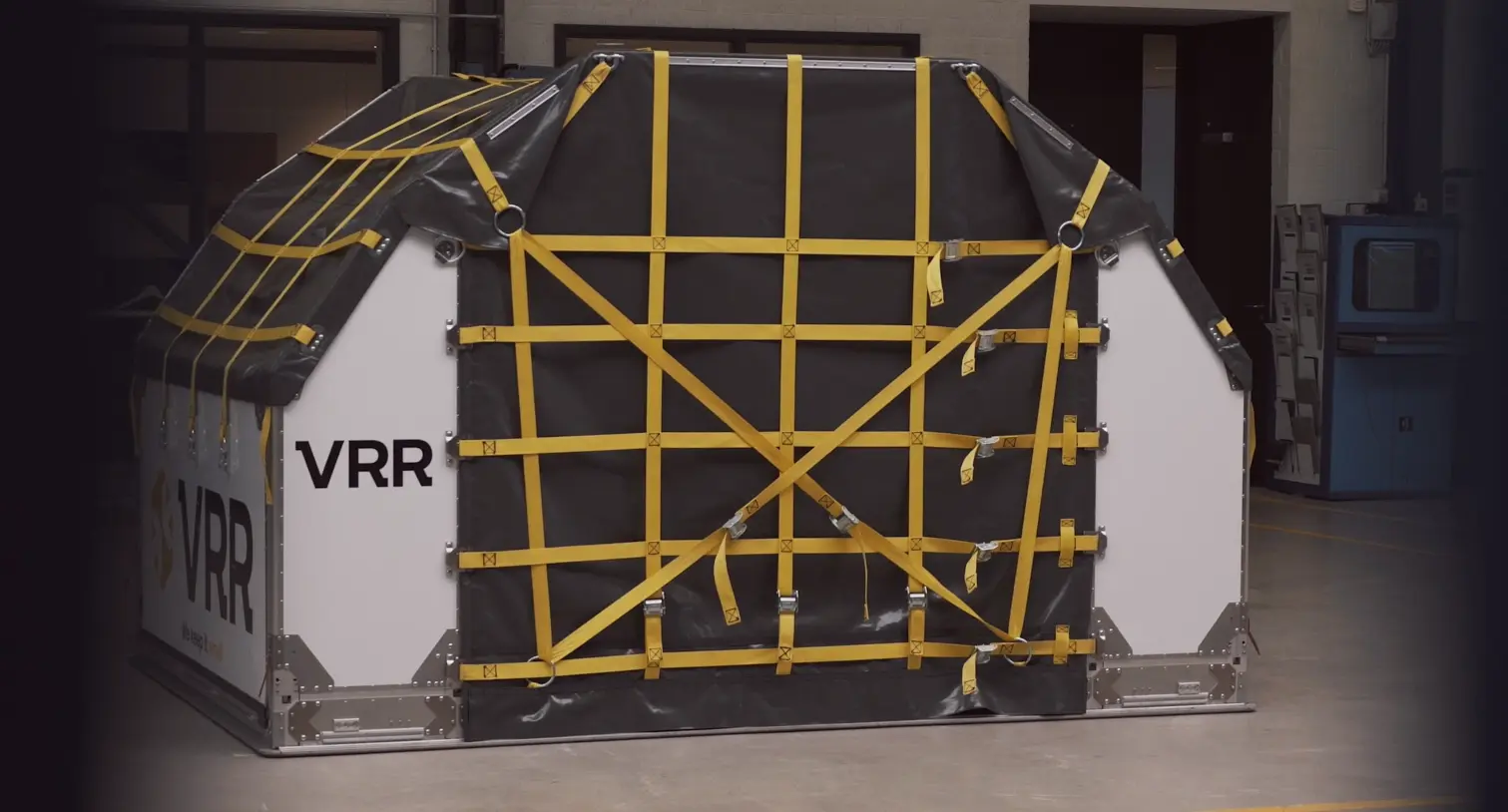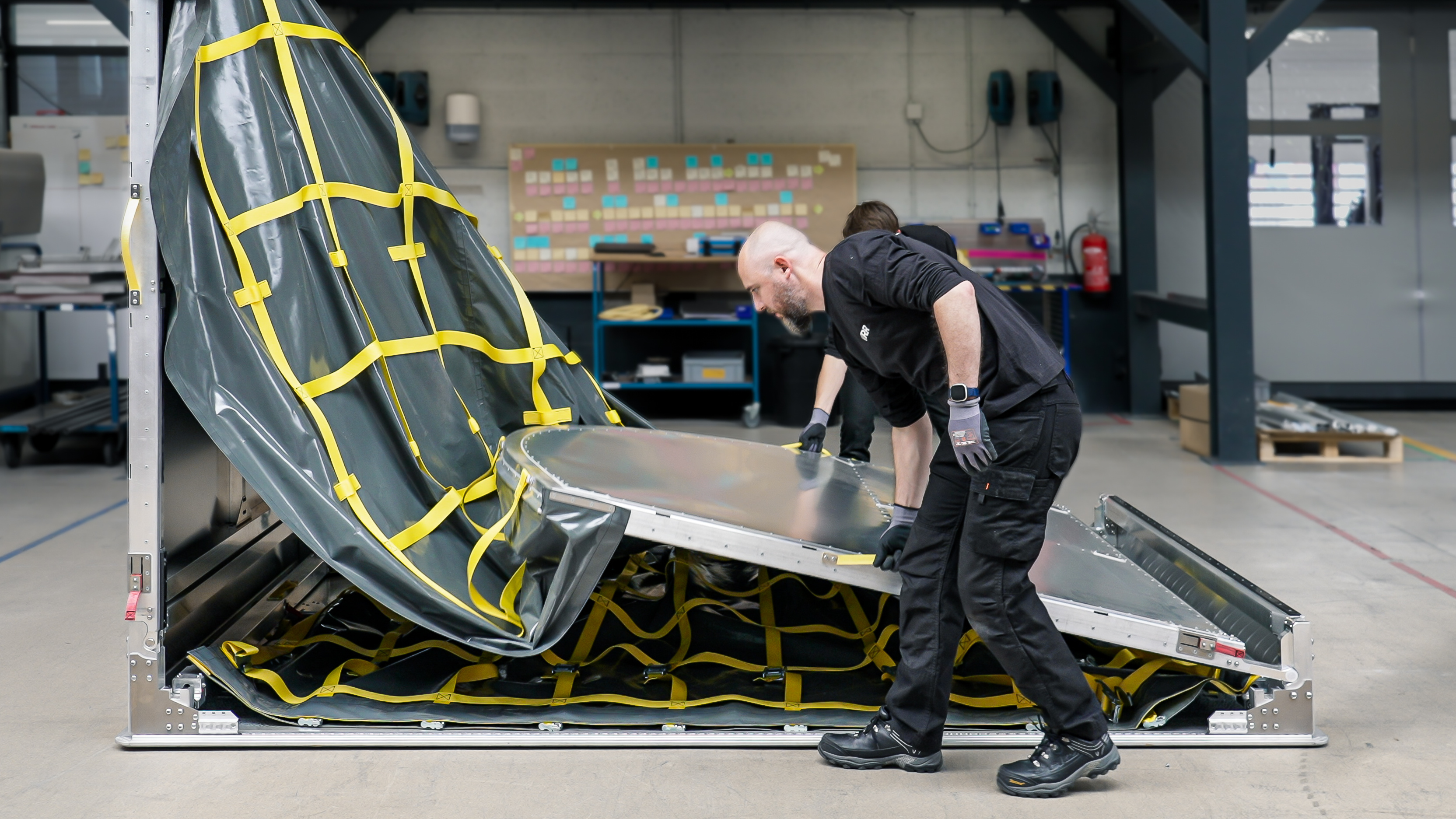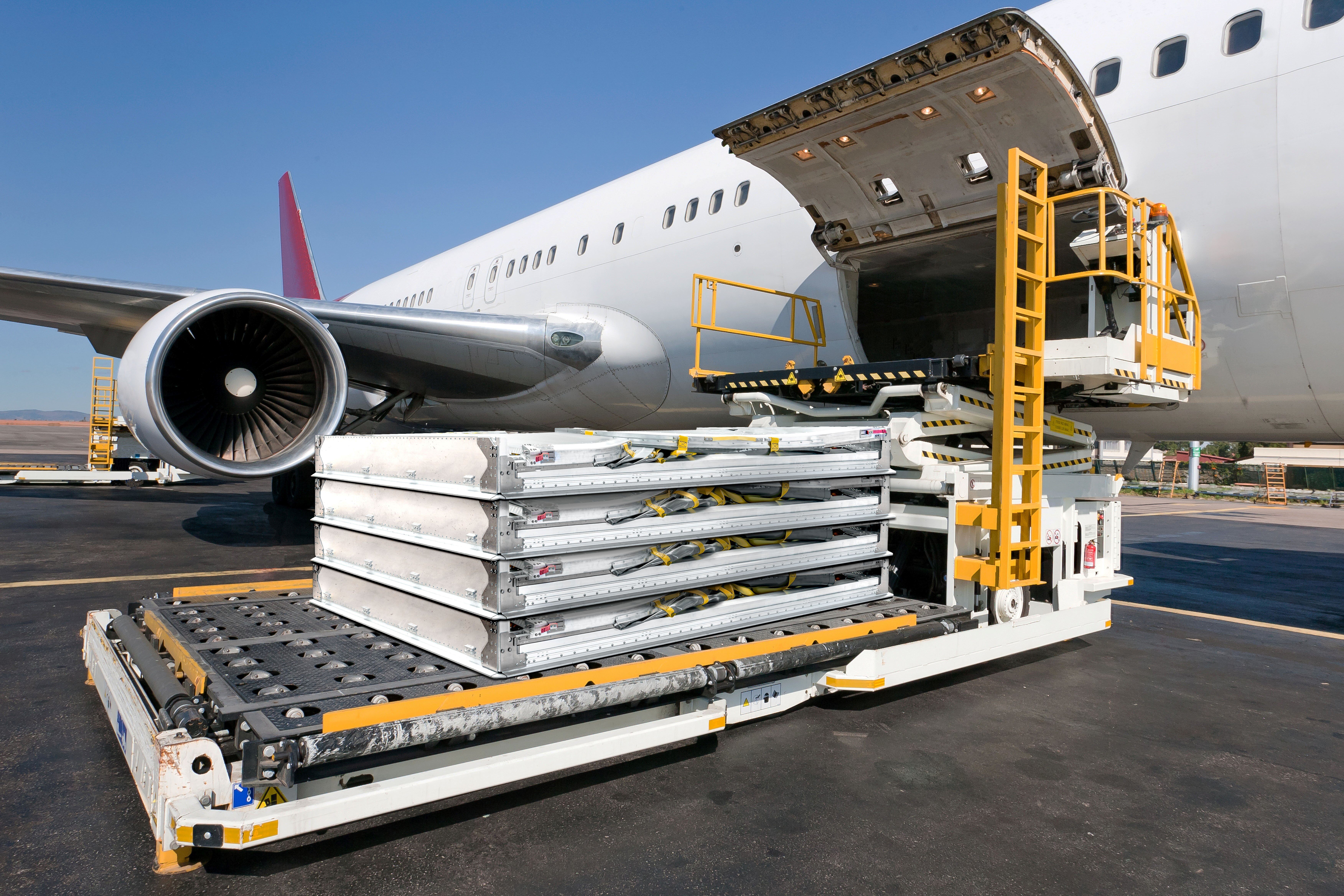VRR and ACL Airshop: A Long Strategic Alliance.
VRR and ACL Airshop are each market leaders in the global air cargo equipment and logistics services sector. They have enjoyed a strategic partnership for over 15 years. The latest collaboration between the two companies flows from a desire to solve a critical operational issue that their customers face every day: the delivery, repositioning and storage of Unit Load Devices.
The AAY Collapsible, developed by VRR, has the same shape, capacity and durability as the standard AAY, so popular with the e-commerce market. However, it can be folded and stacked up to eight high in a truck or warehouse and up to six high in a plane’s hold. It’s a practical solution to an industry-wide problem.
Jos Jacobson, COO of ACL Airshop, was quick to spot the collapsible container’s potential to simplify operations and reduce costs when it was launched. Nevertheless, he had questions: How would it integrate into existing fleets? Would it suffer more wear and tear than a standard container or be too complicated and time-consuming for handlers to operate?
Several months after introducing the AAY Collapsible to his customers, he sat down with VRR to share his experiences and those of his customers.
 Jos Jacobsen, COO and Managing Director-Global Leasing, ACL Airshop LLC
Jos Jacobsen, COO and Managing Director-Global Leasing, ACL Airshop LLC
VRR: Let’s start by asking what led ACL to look at collapsible ULDs.
Jos: Sure. As a leasing company, we need to give our customers instant access to additional containers whenever there's an urgent need, like a last-minute charter or a sudden increase in demand. At the same time, the e-commerce market continues to grow, and a lot of airlines need AAY containers to fill their 737s.
So, we figured, let’s invest in standard AAYs to meet demand, but let’s also look for alternatives that can assist with peak periods and save significant time, space and money. Not just in terms of how many ULDs can fit in a plane’s hold but also how many trucks we use to deliver leased ULDs to our customers.
In Europe, one delivery truck takes only four standard AAYs. That means, to fit out an entire 737, which takes twelve of these containers, you need three delivery trucks. Our customers kept asking us, “Don’t you have a more sustainable and cost-effective solution?” Eventually, we could tell them, “Yes, it’s the AAY Collapsible.”
VRR: You decided to invest in VRR’s collapsible AAY. Why?
Jos: Well, we’re already familiar with VRR’s collapsible horse stalls. They’ve been working very well for us and all our customers for years now. Transporting horses is usually a one-way trip, so we know that collapsing them for the return flight saves a lot of space. The AAY Collapsible is simply another great innovation along the same lines. Plus, it’s certified.
Now, instead of putting only four AAYs in a truck, we can stack eight collapsibles on top of each other. That means sending our customers just one truck of 32 collapsed AAY containers whenever they need extra ULDs for peak periods. It’s a huge logistical saving that they really appreciate.

VRR: What feedback have you had from those operating the AAY Collapsible?
Jos: It’s all been very positive. Of course, we did trials initially to make sure the handling agents could work with the collapsible version. It does need to be expanded, and there’s more canvas. But they came back and said that there’s no big difference between this and the standard AAY, so, yeah, we can use it.
We’ve got several customers using it now, and they all tell us that it doesn't feel like a container you can collapse. It's not like a tent. It's tough and sturdy. It’s also the same size, it has the same volume, and it’s used in the same way. It works perfectly.
So, no complaints whatsoever. On the contrary, once our customers have used the collapsible AAY, they want to use it again and again. The product proves itself.
VRR: So your customers use the AAYc the same way they use the standard AAY?
Jos: That’s right. For me, that's very important. They don't see any difference, even though it can be folded. Typically, we ship them collapsed, and customers expand them at their end. When the lease period is over, they collapse them again and return them to our facilities, where we inspect them and carry out any necessary repairs.
In other words, so far, most of our customers aren’t continuously expanding, collapsing, expanding, collapsing the AAYc. For them, the main benefit is the ability to use it as a fixed container during a peak season and as a collapsible container for delivery and return.
That may be different for other operators, of course. That’s the nice thing about this container. Its flexibility in use. Collapse and expand it according to your needs.

VRR: Are there other benefits to the AAY Collapsible?
Jos: Well, there’s the savings in storage space, of course, which we all know is getting more limited and more expensive by the day. At ACL, we have to store all our assets when they’re not being leased out, but the collapsible AAYs take up far less space than the standard versions because we can stack them on top of one another.
It’s the same deal for customers who continue to lease during low seasons. When they’re not using them, they find a corner for them somewhere. It only takes two minutes and two people to collapse them, which is a great feature. Plus, there’s no need to invest in a racking system, something you have to do if you want to stack standard AAYs.
Couple those savings with the reduced shipping costs, and you really add to the bottom line. Think about it. Logistic costs for trucking companies have increased by around 40% in the last year or two. If you use fewer trucks to get your AAYs, you save a ton of money. A collapsible container may cost a little more to buy, but it’s cheaper to move around and store. It’s a simple calculation.
VRR: What about the universal problem of ULD shortages?
Jos: Oh yes, we use the AAY Collapsible to help us rebalance our stock levels. We don’t have huge quantities of collapsibles right now, so mostly we store them here in Amsterdam. But if we want to reposition them, we just collapse them and fly them to the other side of the world. Because they don’t take up much space in the hold, they make it much easier and cheaper for us to correct any imbalances.

VRR: Many benefits then, but are there any downsides to the AAYc?
Jos: Well, I suppose the downside is that, depending on your operation, you might need a lot of them to help you rebalance your stocks, right? Plus, you need to make sure all the handling agents—who you don’t control—are willing and able to expand and collapse them. That means ground handling staff need to understand what they’re working with. But once it becomes the standard, that won’t be an issue.
There is some manual labour involved as well, although you soon get back that time because it’s quicker to move folded containers around a storage area. The same is true with collapsible horse stalls, of course, only their walls are very heavy to manoeuvre in comparison. The AAY Collapsible is so lightweight that you could do it with one hand.
VRR: Have you ever seen anything go wrong with the container?
Jos: I can honestly say that I haven’t. It’s pretty foolproof. Anybody can collapse and expand it. There's a video on how to do that, and a helpful sticker on the container itself shows you the steps to take. It's all self-explanatory.
We’ve had our guys fold and unfold it without us telling them anything. They just looked at the container, read the instructions or downloaded the video, and presto! It can’t really go wrong. It’s basically three walls and a curtain cover. It’s very simple.

VRR: ULDs operate in a tough environment so they can get damaged. What’s your experience with the AAYc?
Jos: In our experience, they hold up just as well as the normal containers. We do inspect them a little bit more because of all the moving parts. But they’re not like collapsible horse boxes. There are no loose parts. Everything is fixed to the container except, of course, for the cover.
Still, we like to check all the hinges and make sure the cover is watertight because it's a big cover. But, honestly, there's probably even less damage than a normal container. Maybe because the handlers treat it as a special container, but also because of all the stickers and instructions on it.
So, no, we don’t see an increase in damage or repair and maintenance. Only an increase in inspection time, perhaps, but we just want to be careful because it is built differently. The collapsible is a very sturdy container.
VRR: Sustainability is very important in our industry. Do you see the AAY Collapsible helping with this issue?
Jos: I think the combination of more space and fewer plane and truck trips will certainly help companies reduce their carbon footprint. This is all very positive from a sustainability perspective. It may not save hundreds and hundreds of tons of emissions, but there is definitely a saving.
Sustainability is now a permanent requirement. It comes up a lot in discussions with our customers, our vendors and also manufacturers like VRR. So, do I think the AAY Collapsible could improve our sustainability trajectory? Yes, I do.
VRR: Finally, would you recommend the AAY Collapsible to other operators?
Jos: Absolutely, although I understand any hesitation. In the beginning, some of our customers were also unsure. Would it sustain more damage or be too time-consuming to operate? But everyone is pleased. Once it’s set up, it's no different to any other container. And when it’s collapsed, it can be moved about just like a pallet.
At the end of the day, it’s about managing those peak periods and unexpected needs. It’s about reducing your logistical costs and finding more sustainable solutions. The AAY Collapsible can help with all these things. It’s certainly helping us. Combined with our large lease-ready fleet of numerous ULD types and our huge global network of airport hub servicing capabilities, we’re giving customers even more key competitive advantages and cost efficiencies.
Together, ACL Airshop and VRR are providing superior equipment and logistics advantages for airline customers on six continents. Now that’s a strategic alliance.
We thank Jos for taking the time to speak to us about the AAY Collapsible. We hope the experiences of ACL Airshop and its customers show you the practical, commercial and sustainability benefits this innovative ULD can deliver. If you’d like more information on the AAYc, please go to the product page.
ABOUT ACL AIRSHOP: Celebrating its 40th anniversary in 2023, ACL Airshop has four decades of market leadership in cargo control products and customer-leasing ULD solutions. It specialises in short-term leasing, long-term ULD fleet management contracts, repairs, technology innovations and manufacturing, and it offers service capabilities at 57 global airports and a steadily growing network.
ACL Airshop has well over 70,000 ULDs of its own, and, when combined with those that it manages for others, that number grows to 100,000. Known for its high-performance culture, ACL Airshop has the strength of a $5 billion majority shareholder and a reputation for keeping the ACL Brand Promise robust.

.png)
.webp?width=1600&name=ACL%20Airshop%20(met%20achtergrond).webp)


